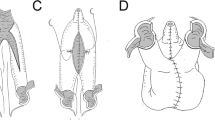Abstract
The purpose of this study was to determine the incidence of nephrolithiasis in radical cystectomy patients treated with either intestinal conduit or continent urinary diversion. The charts from 94 patients who had undergone radical cystectomy with urinary diversion at our institution from 1988 to 1998 were reviewed retrospectively for this study. Charts and radiographs from all patients were examined for renal function and evidence or urinary tract calculi. Two groups were compared: group I patients had undergone diversion with an intestinal conduit, and group II patients had received a continent diversion (primarily involving an Indiana pouch). Conduit diversions were typically done with a freely refluxing anastomosis (Bricker), whereas continent diversions were done with a nonrefluxing ureteral-intestinal anastomosis. Group I consisted of 54 patients who had undergone ileal conduit (50) or colon conduit (4) diversion with a mean follow-up of 2.5 years (range 0.6–7.0 years). Group II consisted of 40 patients who had undergone continent diversion (33 Indiana pouches, 7 orthotopic diversions) with a mean follow-up of 3.1 years (range 0.5–10.5 years). Laboratory studies of serum blood urea nitrogen, creatinine, and CO2 were similar between the two groups. Six patients in group I developed urolithiasis, all in the upper tract. Stones developed at a mean of 3.1 years after urinary diversion. Three patients required operative intervention, whereas the others were managed expectantly. One patient in group II had an upper tract stone at the time of presentation for his bladder cancer, but no patient developed new upper tract stones during the present study period. Two patients in group II developed pouch calculi at a mean of 5 years after diversion; both required surgical intervention. In our study the risk for upper tract urolithiasis seemed higher in the intestinal conduit group (group I), with 11% of the patients developing stones. In the continent diversion group, no patient developed upper tract stones, although two patients (5%) developed pouch stones. Refluxing urine may contribute to an increased risk for stone formation after urinary diversion, whereas pouch stasis may contribute to stone formation in the continent diversion group.
Similar content being viewed by others
Author information
Authors and Affiliations
Rights and permissions
About this article
Cite this article
Turk, T., Koleski, F. & Albala, D. Incidence of urolithiasis in cystectomy patients after intestinal conduit or continent urinary diversion. World J Urol 17, 305–307 (1999). https://doi.org/10.1007/s003450050151
Issue Date:
DOI: https://doi.org/10.1007/s003450050151




